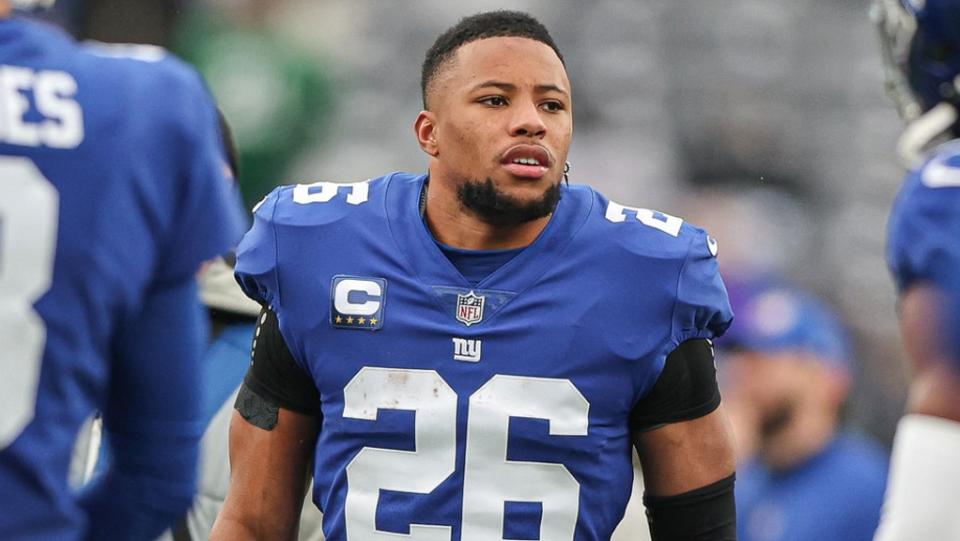
There’s usually some give-and-take in a contract negotiation. Not this time. The Giants looked at Saquon Barkley, then took, took and took some more.
The all-world running back is back for the start of training camp, reporting to East Rutherford on Tuesday on a signed revised franchise tag.
The base is still a shade under $10.1 million, only now, the Giants gave him $2 million of that up front. They’re then giving him a chance to earn another $1 million in performance-based incentives.
Along with…
Wait, no, actually that’s pretty much it.
All of those incentives are tied to the back dominating the field (1,350 rushing yards, 65 catches, or 11 total touchdowns) and the Giants making the postseason — both need to happen. The contract does not include written or verbal acknowledgment that the Giants won’t just tag Barkley again if he performs well.
You can’t help but tip your cap to GM Joe Schoen. To somehow get this deal signed is a masterclass in contract negotiation.
The Giants had all the leverage, that’s the way the franchise tag works. The moment they placed that on their tailback the ball took up permanent residence in their court.
Still, across the league, franchise tags usually just buy time as the two sides reach a long-term extension. The problem with Barkley and the Giants was not the desire from both to keep him in New York long term, but the position Barkley plays.
The running back market is a disaster. Teams just aren’t willing to pay top dollar to a position they don’t value — there’s little point in rehashing this. It’s understandable, though. A back’s success is largely tied to the offensive line in front of him. Have a good line, and it’s easy to make an average runner look great. Maybe most damning, though: The shelf life of a back’s career just isn’t the same as other positions.
So, teams aren’t paying running backs like other positions. Barkley wanted top dollar. There was absolutely no reason for the Giants to give him top dollar when he wouldn’t find that money elsewhere. That’s why they didn’t. The deadline for Barkley to sign a long-term contract extension came and went with little legitimate movement.
But that doesn’t explain how we got here.
The Giants made Barkley three separate contract offers between the bye week and Tuesday, sources told SNY. This one was undeniably the weakest of the bunch. Yet this is the one with Barkley’s John Hancock scribbled across.
After July 15th, Barkley really only had one option: Hold out. It seemed like he was preparing to do just that, too. He wanted to make a statement on behalf of all backs — help rectify a broken system. He could do that by sitting out training camp and the preseason. Maybe stretch it into September and October when things matter? Unlike others, Barkley was in a unique position as the unquestioned best player on the Giants roster. They made the playoffs last year in large part because of him. They clearly didn’t believe he was worth what he was asking for. That’s fine. Now go try and win without him.
Instead Barkley and his representation caved. By signing this, Barkley hurts the market even more. Forget the monetary value — there’s no clause added prohibiting the Giants from tagging him again.
And, now, Barkley’s best option might be for the Giants to tag him again.
In order for Barkley to justify a big-money extension after this season, he’s going to have to play out of his mind this season. That means hitting many of those lofty performance incentives included in his contract. Running backs aren’t like receivers or quarterbacks. Barkley will need anywhere from 350 to 400 (or more) touches to do that.
And, unlike many other positions, that many touches, even though leading to production, is considered a detriment. It adds mileage to tires. Combine that with Barkley turning 27, and it’s easy to see why this offseason was his best, and potentially only, chance at a long-term extension.
Dalvin Cook is 27 — like Barkley soon will be. The Vikings cut him after he tallied 1,457 total yards and 10 touchdowns last year. He remains unsigned. The Bengals were going to do the same with the 27-year-old Joe Mixon. He took a $3 million pay cut after totaling 1,255 yards from scrimmage and nine touchdowns.
The 49ers (Christian McCaffrey), Saints (Alvin Kamara), Browns (Nick Chubb) and Packers (Aaron Jones) can all get out of their back’s contracts — four of the five highest paid at the position — next offseason. What justification will there be for any team to give big money to Barkley if not even those players are compensated?
The Giants should be thrilled. This offense is better (on paper) than it was a year ago, but there’s no denying Barkley is their most talented weapon. They now have him back.
The same cannot be said for Barkley.
His first drop of the season came before Week 1.